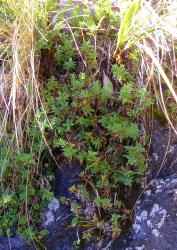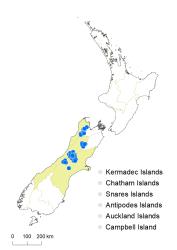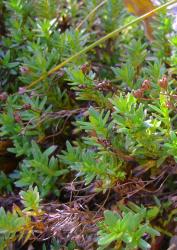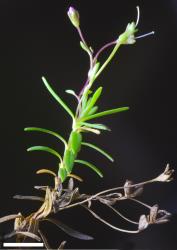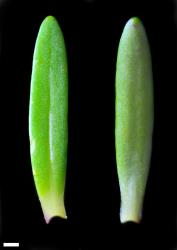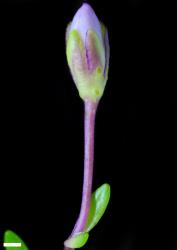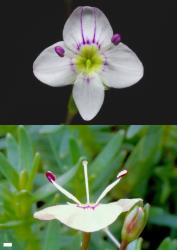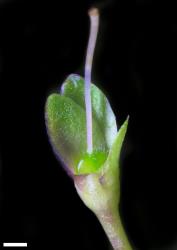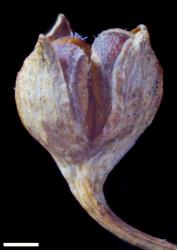- ≡ Hebe linifolia (Hook.f.) Anderson, Trans. New Zealand Inst. 56: 693 (1926)
- ≡ Parahebe linifolia (Hook.f.) W.R.B.Oliv., Rec. Domin. Mus. 1: 230 (1944)
Sub-shrub to 0.3 m tall. Stems decumbent to ascending, eglandular-pubescent; hairs sparse, bifarious, at distal end of internodes. Leaf bud indistinct, leaves separating while very small, opposite-decussate, erect to reflexed, separating early; lamina sub-coriaceous, linear to narrowly oblong, 10–30 mm long, 1.5–3.5 mm wide, glossy green above, dull pale green beneath; midrib evident; surfaces glabrous; margin ciliate, especially towards the base, entire; apex rounded; base cuneate; petiole 1.4–4.0 mm long. Inflorescence a lateral raceme; flowers distant, 2–8 (rarely 1), all bisexual; bracts alternate, or the lower sub-opposite, linear to narrowly deltoid, < pedicels; pedicels sub-erect, incurved at fruiting, 8–40 mm long, glabrous. Calyx lobes 4, sub-acute to acute, sub-equal, 3–6 mm long, glabrous or eglandular-ciliate. Corolla 12–17 mm diameter; tube white and yellow, 0.5–1.5 mm long, < calyx, eglandular-hairy inside; lobes 4, white, sometimes blue, rarely pink, spreading to recurved, unequal, elliptic to orbicular or rhomboid, 5–9 mm long, obtuse, or posterior lobe emarginate; nectar guides magenta to purple. Stamen filaments white, 4–8 mm long; anthers magenta, rarely pink. Style glabrous, 4–9 mm long. Capsules broadly angustiseptate, didymous, glabrous or rarely eglandular-hairy at apex, 3.0–4.5 mm long, 3.5–4.5 mm at widest point. Seeds discoid to ellipsoid, flattened, smooth, pale to dark brown, 0.7–1.2 mm long.
colostylis | linifolia | |
|---|---|---|
Leaf length (mm) | (5–)8–12(–15) | (10–)12–20(–30) |
Pedicel length (mm) | (4–)6–12(–15) | (8)–13–30–(40) |
Corolla | white, nectar guides absent or rarely faint, pink, on posterior lobe. | white or pale blue (rarely pink), with magenta nectar guides on posterior and lateral lobes. |
Stamens | erect; filaments 1–3 mm long | diverging; filaments (4)–6–8 mm long |
Style length (mm) | 2–4 | (4)–6–8(–9) |
South Island: Western Nelson, Canterbury from Rangitata River north, Westland from Mt Alexander north.
Montane to alpine cliffs, rock outcrops, river gravel, and river banks. Recorded elevations range from 731 to 1646 m.
Flowers: December–April; fruits: January–May, persisting to November.
2n = 42 (Hair 1970, as Parahebe linifolia).
Veronica linifolia is classified in V. subg. Pseudoveronica sect. Hebe and informally in the “speedwell hebe” group (Albach & Meudt 2010). It is likely to be sister species to V. colostylis, a hypothesis supported by ITS data (Wagstaff et al. 2002) and by their shared unusual morphology. V. linifolia appears to belong with V. lyallii and several other species in a clade (the speedwell hebes, Albach & Meudt 2010) that is characterised by short corolla tubes, nectar guides on the corolla, and rather lax inflorescences, although V. spathulata and usually V. colostylis lack nectar guides. Most also have plicate lateral corolla lobes, which enfold the stamens, but V. linifolia, V. spathulata, and V. colostylis, along with V. lilliputiana and V. jovellanoides, lack these. However, analysis of DNA sequence data places V. linifolia either as sister to the shrubby hebes (Albach & Meudt 2010, ITS and combined ITS/cpDNA data), to form a group characterised by entire leaves, or as sister to the speedwell hebes (Wagstaff et al. 2002, ITS data; Albach & Meudt 2010, cpDNA data).
V. linifolia flowers vary in corolla colour. In the Owen Range, Nelson, plants consistently have blue flowers. In other locations the flowers are white, with magenta nectar guides, except that individual plants sometimes have pink corollas (e.g., at Sudden Creek, Arthur’s Pass National Park).
Cultivars
Blue-flowered plants from the Owen Range, Nelson, have been brought into cultivation as cv. 'Blue Skies'.



